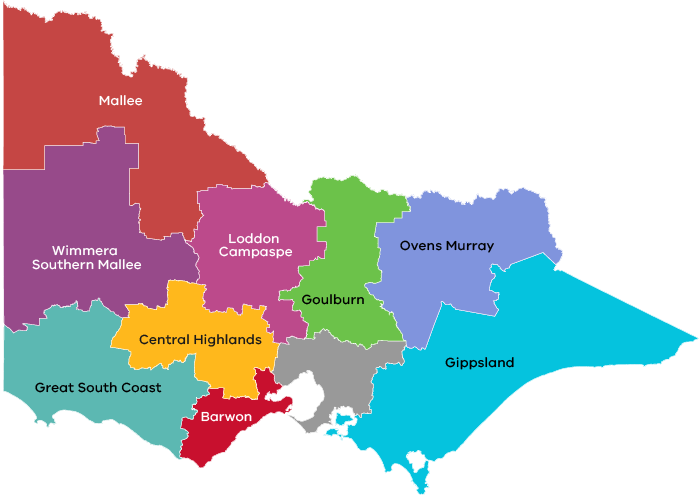 What are Regional Partnerships?
What are Regional Partnerships?
What do Regional Partnerships do?
How do Partnerships engage with communities?
What impact are the Regional Partnerships having?
How do I find my local Regional Partnership?
How can I have my say?
What are Regional Partnerships?
Victoria’s 9 Regional Partnerships were established by the Victorian Government in 2016 recognising that local communities are in the best position to understand the challenges and opportunities faced by their region.
Through ongoing consultation, the Partnerships ensure regional communities have a greater say about what matters to them, and that the voices of these communities are heard directly at the heart of Government.
The nine Regional Partnerships are shown on the map below. They are from west to east: Mallee, Wimmera Southern Mallee, Great South Coast, Central Highlands, Loddon Campaspe, Barwon, Goulburn, Ovens Murray and Gippsland.

Each Regional Partnership is made up of community and business leaders who are passionate about regional Victoria. They are joined on the Partnership by the CEOs of local councils, a representative of Regional Development Australia and a Victorian Government Deputy Secretary, ensuring all levels of Government are represented.
What do Regional Partnerships do?
Regional Partnerships engage with their communities and local stakeholders year-round to identify priorities for their regions and develop collaborative solutions to local problems.
From transport and education, to tourism, health and economic opportunities, the Regional Partnerships provide an opportunity for local communities to have their voices heard and acted on.
The Partnerships provide advice directly to the Victorian Government about regional priorities so they can then be incorporated into government policies, programs and planning.
Partnerships work across all government portfolios and with the three levels of government to address the often complex issues facing rural and regional communities. They build on and complement existing regional leadership and working groups and strategic planning processes.
How do Partnerships engage with communities?
Having heard from a large number of community members through Regional Assemblies between 2016 and 2018, the Partnerships published their Outcomes Roadmaps in early 2019. These are a summary of the key long-term strategic areas of focus for each Partnership moving forward. The Roadmaps outline where each Partnership is looking to make a real difference.
Partnership engagement is now much more focused than in previous years, focusing on engaging with key stakeholders in a small number of priority areas. These areas align with the Partnership’s long term priorities as expressed in the Outcomes Roadmaps. The intention is for a focusing of effort to enable real change of the ground.
From 2016 to 2018, Regional Assemblies were a major feature of Regional Partnership engagement with their communities. Assemblies were large, town hall-style community gatherings where many locally-important issues were discussed. They helped Partnership members appreciate the full range of issues in their region, as well as garnering suggestions for tackling these issues. In 2018, more than 2,000 people attended a Regional Assembly. In addition to Assemblies, each Partnership held smaller meetings with specific groups in their communities.
What impact are the Regional Partnerships having?
Regional Partnerships, and the communities they represent, are seeing the results of their work, with the Victorian Government listening to, and investing in, what Partnerships – and their communities – are asking for.
They are also successfully bringing different levels and parts of Government and different community groups together, to build relationships, share ideas, speak and solve issues in regions. They are having an impact on the way government works and delivers services and programs in regional areas. They are leading to a focus on local issues and government policies, and their impact, at the local placed-based level.
You can read more about each Regional Partnership’s achievements by following the links below.
How do I find my local Regional Partnership?
Regional Partnership boundaries were mapped in consultation with local communities, bringing together areas with common interests. As a result, the Partnerships are smaller than Regional Development Australia areas and Regional Development Victoria’s 5 administrative boundaries.
The 9 Regional Partnerships are:
- Barwon - Colac Otway (Shire), Greater Geelong (City), Queenscliffe (Borough), Surf Coast (Shire)
- Central Highlands - Ararat (Rural City), Ballarat (City), Golden Plains (Shire), Hepburn (Shire), Moorabool (Shire), Pyrenees (Shire)
- Gippsland - Bass Coast (Shire), Baw Baw (Shire), East Gippsland (Shire), Latrobe (City), South Gippsland (Shire), Wellington (Shire)
- Goulburn - Greater Shepparton (City), Mitchell (Shire), Moira (Shire), Murrindindi (Shire), Strathbogie (Shire)
- Great South Coast - Corangamite (Shire), Glenelg (Shire), Moyne (Shire), Southern Grampians (Shire), Warrnambool (City)
- Loddon Campaspe - Campaspe (Shire), Central Goldfields (Shire), Greater Bendigo (City), Loddon (Shire), Macedon Ranges (Shire), Mount Alexander (Shire)
- Mallee - Buloke (Shire), Gannawarra (Shire), Mildura (City), Swan Hill (Rural City)
- Ovens Murray - Alpine (Shire), Benalla (City), Indigo (Shire), Mansfield (Shire), Towong (Shire), Wangaratta (Rural City), Wodonga (Rural City)
- Wimmera Southern Mallee - Hindmarsh (Shire), Horsham (Rural City), Northern Grampians (Shire), West Wimmera (Shire), Yarriambiack (Shire)
How can I have my say?
You can find out more about your local Partnership, including contact details, by viewing the individual Partnership's page.
